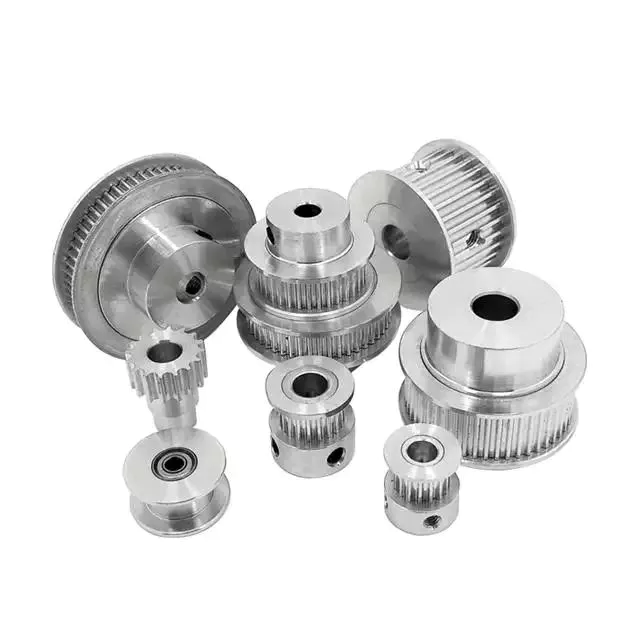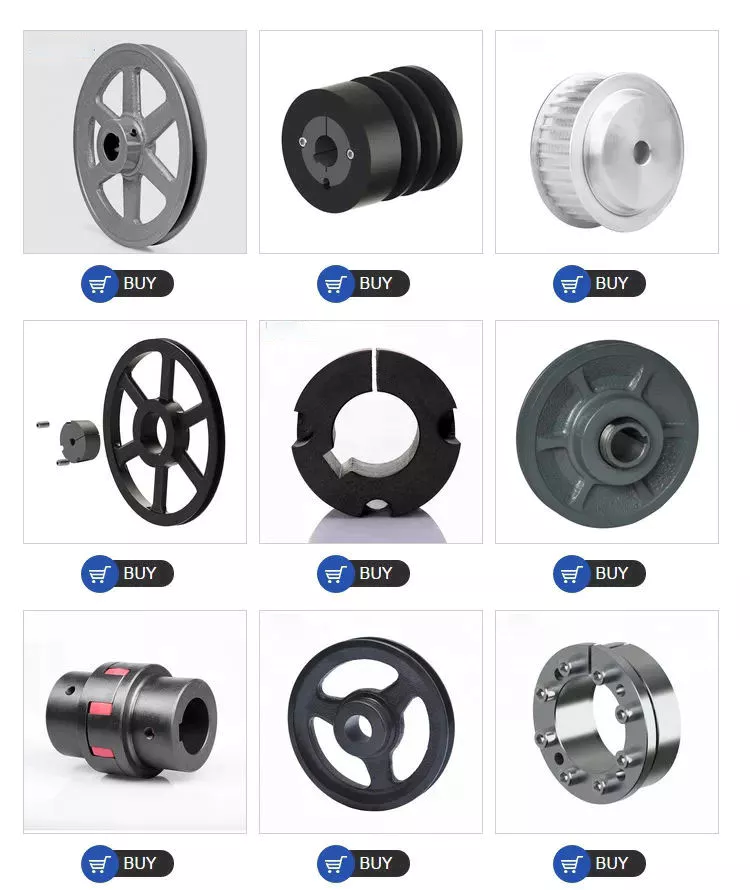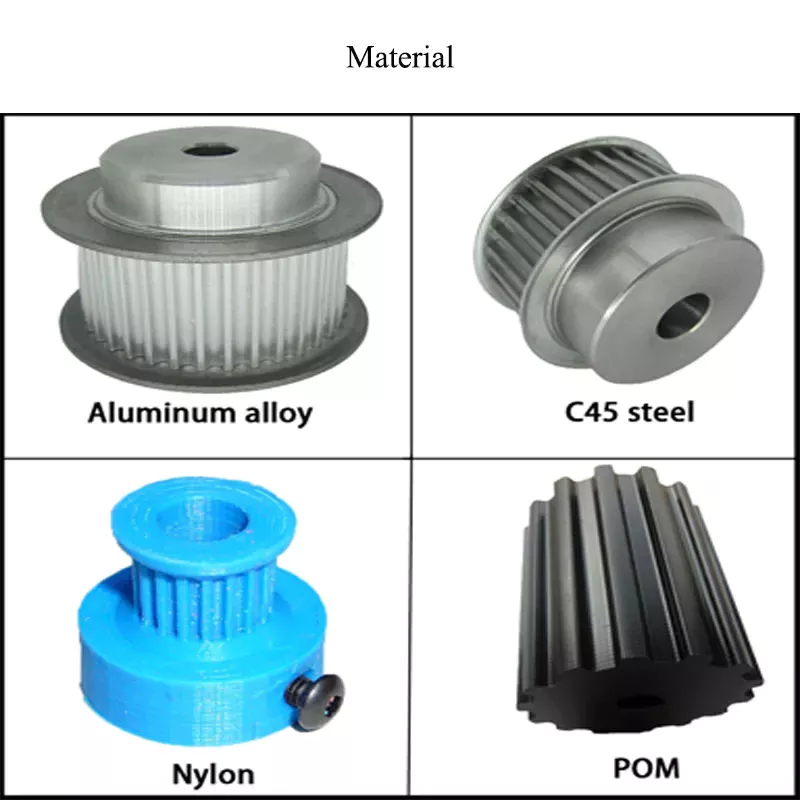Product Description
YQBW-571 Engine Crankshaft Pulley For MINI 02-08
Product Description
Crankshaft Pulley
The crankshaft pulley (harmonic balancer) is mounted on the end of the crankshaft. Its purpose is to turn the drive belts that operate the engine accessories (alternator, air conditioning compressor, etc.)
Symptoms of a Bad or Failing Crankshaft Pulley
Knocking noise
Engine accessories may stop working
Crankshaft Pulley Related Repair Advice
The crankshaft bolt securing the pulley can loosen, affecting the operation of the pulley
The harmonic balancer includes a rubber insert between the center portion of the crankshaft pulley and the outer surface; this is what drives the belts
The rubber insert can become damaged, resulting in an abnormal noise. The outer surface can also “slip” on the rubber insert, which can affect the ability to set the ignition time on older engines
An automobile engine crankshaft pulley structure
The pulley refers to the flywheel connected to the crankshaft of the engine.
It was originally designed to drive the camshaft to rotate to drive the engine accessories, such as controlling the engine's gas distribution system. When the engine is running, the stroke of the piston (up and down movement) valve The pulleys are generally made of cast iron as the timing action of the camshaft opens and closes in sequence.
At present, the belt pulley is generally fixed by bolts, and the bump on the front end of the crankshaft of the engine is stuck in the square hole in the center of the pulley to achieve a fixed connection with the crankshaft.
When the engine is running, the crankshaft vibrates violently under the drive of the cylinder piston.
The running of the bolt will cause the loosening of the bolt. In the prior art, the static friction between the front end of the bolt and the inner wall of the fixing hole is mainly used to prevent the bolt from loosening. However, this method will cause pressure on the bolt to deform it and eventually destroy the bolt, causing the bolt to loosen again; when the pulley is connected to the belt for conduction because the belt is stretched by high strength for a long time to cause self-aging, it is easy to take off the pulley phenomenon.
In the prior art, limit plates are generally installed at both ends of the pulley, but the belt is easy to separate The friction of the limiting plate causes loss.
Product Parameters
|
ITEM: |
SAP Crankshaft Pulley |
|||
|
OEM: |
Accept |
|||
|
MOQ: |
1 pcs (If the goods have ex-stock, small quality will be available) |
|||
|
BRAND: |
SAP Brand or Customer's Brand |
|||
|
PACKING: |
Natural Packing or Packing as Customers required |
|||
|
PAYMENT: |
L/C, T/T, Western Union, MoneyGram.etc, |
|||
|
WARRANTY: |
12 Months |
|||
|
PORT: |
ZheJiang /HangZhou |
|||
|
ADVANTAGE: |
Good Quality and Competitive Price |
|||
|
SAMPLE: |
Customized Sample |
|||
|
Quality: |
Produce According to ISO/TS 16949:2002 Standard |
|||
|
TEAM: |
Powerful Production and R&D Capability |
|||
Company Profile
ZheJiang Strong Auto Parts Co., Ltd. is a professional manufacturer of many kinds of automobile control arms and automobile pulleys founded in 1995. We have registered 2 famous brands ”STRONG”and”SAP” in China. With constant technical innovation and persevering high professional dedication, Strong company has owned a strong ability for research and development through the adoption of the advanced manufacturing process in the world, with scientific management and a strict product quality control system, Strong company has succeeded in passing the Germany certification in 2009.
ZheJiang Strong Auto Parts Co., Ltd. has many kinds of control arms and pulleys, we are a leading manufacturer of alternator overrunning pulleys and crankshaft damper pulleys, and car control arms on its processing, many technologies we have our invention patented in China, and the production capacity per year can be several million pieces. Now our products have been exported to many European, American, and Canadian countries for many years.
ZheJiang Strong Auto Parts Co., Ltd. has developed its own unique people-centered cooperation culture featuring ”technology innovation, people-oriented, integrity cooperation, and pursuit perfection”, we persevere in our efforts to improve our equipment performance and worker ability, and we sincerely hope to build good cooperation with you for our mutual prosperous business through our high-quality products and best service.
/* March 10, 2571 17:59:20 */!function(){function s(e,r){var a,o={};try{e&&e.split(“,”).forEach(function(e,t){e&&(a=e.match(/(.*?):(.*)$/))&&1
| After-sales Service: | Yes |
|---|---|
| Application: | Excavator, Lawnmower, Tractor, Ke Tan, Boat, Motorbike, Truck, Car |
| Certification: | RoHS, TS16949, ISO 9001, CE |
| Warranty: | 6 Months |
| Engine Type: | Gasoline |
| Material: | Forged Steel |
| Samples: |
US$ 30/Piece
1 Piece(Min.Order) | |
|---|
| Customization: |
Available
| Customized Request |
|---|

Can you explain the concept of “efficiency” in pulley systems?
In pulley systems, efficiency refers to the ratio of output work or power to the input work or power, taking into account any losses or inefficiencies in the system. It represents how effectively the pulley system converts the input energy into useful output energy.
The efficiency of a pulley system can be affected by various factors, including friction, mechanical losses, and the design and condition of the pulleys and ropes. Here are some key points to understand about efficiency in pulley systems:
1. Mechanical Advantage and Efficiency: Pulley systems can provide a mechanical advantage by reducing the effort force required to lift a load. However, it's important to note that while a higher mechanical advantage generally means less effort is needed, it may also result in lower efficiency. This is because as the mechanical advantage increases, the system may experience higher frictional losses and other inefficiencies.
2. Friction and Efficiency: Friction plays a significant role in the efficiency of pulley systems. The interaction between the pulley wheels and the ropes or belts can result in frictional losses, which reduce the overall efficiency of the system. Friction can be minimized by using pulleys with low-friction bearings or by lubricating the contact surfaces.
3. Rope or Belt Material: The choice of rope or belt material can impact the efficiency of a pulley system. Different materials have varying coefficients of friction, flexibility, and durability, which can affect the overall efficiency. For example, using a rope or belt with low friction and high strength can help reduce energy losses and improve efficiency.
4. Pulley Design and Condition: The design and condition of the pulleys also influence efficiency. Pulleys should be properly aligned, have smooth surfaces, and be free from damage or wear. Misaligned or worn pulleys can increase friction and decrease efficiency.
5. System Load: The efficiency of a pulley system can vary based on the magnitude of the load being lifted or moved. Higher loads can result in increased friction and mechanical losses, leading to lower efficiency.
Efficiency is typically expressed as a percentage, with 100% representing a perfectly efficient system where all the input energy is converted into useful output energy. In real-world pulley systems, efficiency is often less than 100% due to various factors, including friction, heat generation, and other losses.
It's important to consider efficiency when designing or evaluating pulley systems. Higher efficiency means a more effective use of input energy, reduced energy waste, and improved overall performance.

What is the importance of proper pulley alignment and tensioning?
Proper pulley alignment and tensioning are critical factors in ensuring the efficient and reliable operation of pulley systems. They play a significant role in maximizing power transmission, minimizing wear and tear, and maintaining the overall performance and longevity of the system. Here's the importance of proper pulley alignment and tensioning:
1. Power Transmission Efficiency:
Proper pulley alignment and tensioning ensure optimal power transmission efficiency. When pulleys are misaligned or belts/chains are improperly tensioned, energy is wasted due to increased friction and slippage. This results in decreased power transfer and reduced system efficiency. By aligning the pulleys parallel to each other and applying the correct tension to the belts or chains, the system can achieve maximum power transmission, minimizing energy losses.
2. Belt/Chain Longevity:
Correct pulley alignment and tensioning contribute to the longevity of belts and chains. Misalignment and inadequate tension can cause uneven wear, excessive stretching, and premature failure of the belts or chains. Proper alignment and tension distribute the load evenly across the belts or chains, reducing stress and extending their lifespan. This helps to avoid unplanned downtime, maintenance costs, and the need for frequent belt/chain replacements.
3. Reduced Noise and Vibration:
Improper pulley alignment and tensioning can lead to increased noise and vibration in the system. Misaligned pulleys or loose belts/chains can cause excessive vibration, resulting in noise, equipment damage, and discomfort to operators or nearby personnel. Proper alignment and tensioning help minimize vibration, ensuring quieter operation and a more comfortable working environment.
4. System Reliability and Safety:
Proper alignment and tensioning contribute to the overall reliability and safety of pulley systems. Misaligned pulleys or loose belts/chains can lead to unexpected failures, breakdowns, or accidents. Over-tensioning can also cause excessive stress on components and increase the risk of system failures. By maintaining proper alignment and tension, the system operates within its design parameters, reducing the likelihood of unexpected failures and ensuring the safety of operators and equipment.
5. Improved Performance:
Correct pulley alignment and tensioning enhance the overall performance of the system. Properly tensioned belts or chains provide better grip and traction, allowing for smoother and more precise movement of the driven components. This results in improved speed control, reduced slippage, and enhanced accuracy in applications such as conveyor systems, machine tools, and automotive engines.
6. Maintenance and Cost Savings:
Proper pulley alignment and tensioning can lead to significant maintenance and cost savings. Well-aligned pulleys and correctly tensioned belts or chains experience less wear and require fewer adjustments. This reduces the frequency of maintenance tasks, such as belt/chain replacements, realignments, and re-tensioning. Additionally, by maximizing power transmission efficiency and minimizing wear, proper alignment and tensioning help reduce energy consumption and lower operating costs.
In conclusion, proper pulley alignment and tensioning are crucial for achieving optimal power transmission efficiency, prolonging the lifespan of belts or chains, reducing noise and vibration, ensuring system reliability and safety, improving performance, and realizing maintenance and cost savings. It is essential to follow manufacturer guidelines and perform regular inspections and adjustments to maintain proper alignment and tension in pulley systems.

What safety precautions should be observed when using pulleys?
When using pulleys, it is important to observe several safety precautions to ensure the well-being of individuals involved and prevent accidents. Here are some key safety precautions that should be followed:
1. Proper Training: Individuals who operate or work around pulley systems should receive proper training on their usage, including understanding the equipment, safety procedures, and potential hazards. Training should cover topics such as load limits, proper lifting techniques, and the importance of following safety guidelines.
2. Inspections and Maintenance: Regular inspections and maintenance of pulleys are crucial for identifying any signs of wear, damage, or malfunction. Inspect pulleys for cracks, deformation, excessive wear, or any other issues that may compromise their integrity. Replace damaged or worn-out pulleys immediately to prevent accidents.
3. Load Capacity: Ensure that the load being lifted or moved does not exceed the rated load capacity of the pulley system. Exceeding the load capacity can lead to overloading, which may result in equipment failure, accidents, or injuries. Refer to the manufacturer's guidelines or load capacity charts for proper load calculations.
4. Secure Attachment: Ensure that pulleys are securely attached to their mounting points or support structures. Loose or improperly secured pulleys can cause the load to shift or fall, posing significant safety risks. Use appropriate hardware, such as bolts or clamps, and follow manufacturer recommendations for proper attachment methods.
5. Personal Protective Equipment (PPE): Individuals involved in pulley operations should wear the necessary PPE, depending on the specific hazards present. This may include safety helmets, gloves, safety glasses, and appropriate footwear. PPE helps protect against potential injuries from falling objects, impacts, or contact with moving parts.
6. Clear Work Area: Maintain a clear work area around the pulley system. Remove any obstructions, debris, or tripping hazards that could impede safe operation or cause accidents. Adequate space should be provided for safe movement and positioning of individuals involved in the operation.
7. Communication and Signaling: Establish clear communication and signaling protocols when working with pulleys. Use standardized hand signals or communication devices to ensure effective communication between operators, spotters, and other personnel involved. This helps coordinate movements, avoid misunderstandings, and prevent accidents.
8. Emergency Stop Procedures: Familiarize yourself with the emergency stop procedures for the pulley system. Ensure that all individuals involved are aware of how to quickly and safely stop the operation in case of an emergency or unexpected event. Clearly mark emergency stop buttons or switches and ensure they are easily accessible.
9. Lockout/Tagout: If performing maintenance, repairs, or adjustments on the pulley system, follow proper lockout/tagout procedures to isolate energy sources and prevent accidental startup. Lockout/tagout procedures help protect against unexpected movements or releases of stored energy.
10. Risk Assessment: Conduct a thorough risk assessment before using pulleys. Identify potential hazards, evaluate associated risks, and implement appropriate control measures to mitigate those risks. Regularly review and update risk assessments as necessary.
It is essential to consult relevant industry standards, guidelines, and local regulations specific to your application or jurisdiction to ensure compliance with safety requirements when using pulleys.


editor by CX
2024-02-03
